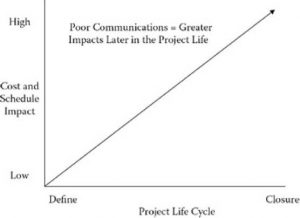Service contractors are notoriously bad with project management communication. Finding support for this statement is not very difficult; just ask a handful of neighbors what they would want from a good home improvement contractor. You will get responses like answer the phone, return phone calls and emails, show up on time, provide realistic expectations or simply finish the job. The baseline expectations of the average consumer are actually pretty low. Yet, many contractors still can’t meet them when it comes to project management communication.
Why Communication Is Important in Restoration Project Management
Multiple studies conducted by the Project Management Institute (PMI), Forbes and the Society for Human Resource Management (SHRM) reveal that hundreds of millions

of dollars each year are lost by companies due to poor project communication. The PMI claims this represents as much as 7.5% of a project’s budget. For restoration contractors, this can be the difference between a positive or negative bottom line at the end of the year. Furthermore, project communication failures reveal themselves in the most vulnerable area of the business — accounts receivable and cash flow.
So, in a time when production schedules are full, lead times are long, and resources thin, what exactly are contractors to do to appease their customers? The answer can be found in improving project communication. While this might seem to be a daunting task for some, a simple tool that can be used to guide the efforts is a project communication plan.
This straightforward and effective instrument is so powerful that a previous graduate of Violand’s Restoration Project Management program once referred to it as “the $800K document.” It helped him secure an $800K commercial mold remediation project when, during the bid process, the property manager asked how they planned to keep all parties on the same page throughout the project.
5 Elements Project Management Communication Plan
The purpose of the communication plan is to improve communication by identifying the five elements of information that are necessary to achieve effective communication during a project: audience, output, frequency, delivery method and lead. Let’s look at each of them in more detail to gain a greater understanding of just how simple this concept is.
- The audience can also be defined as stakeholders. Stakeholders are individuals, not entities, who have a material interest in the project. Creating an exhaustive list of stakeholders for any project can be a challenge and as soon as you think you have them all, you always find more. For the sake of discussion, I would recommend identifying the key stakeholders that would be consistent across most projects. Examples of these would be the customer, client, referral source, agent, broker, adjuster, supplier, subcontractor, technician, tradesman and any members of the project team. These are individuals who have direct influence on the outcome of the project.
- Output is any and all information relative to the project. If the audience is the “who” or receiver of the communication, the output is the “what” or the information to be transferred to those individuals. This is, of course, relative to the audience. Not all stakeholders are going to want to be involved with every facet of the project, nor should they be, as too much information can be dangerous and create situations of conflicting opinions and unnecessary influence. Consequently, careful consideration needs to be given to what is communicated so as not to create issues rather than avoid them. Gathering and setting appropriate expectations with the stakeholders at the beginning is usually the best way to ensure that all parties are on the same page.
- Frequency of communication can be a loaded gun in a time when society holds instant information in the palm of its hands. Gone are the days when people couldn’t be reached if they weren’t at home or in the office. Today, people expect an immediate response, regardless of what expectations are set. This can be tricky because project managers can get bogged down with the constant communication that is coming their way all day, sucking up valuable time that should be spent planning and directing activities. This is where routines need to be established so customers and project team members develop a rhythm of communication that is predictable and effective, focusing on the right information at the right time.
- Equally as sensitive is the delivery method. One of the greatest struggles with communication in today’s business world is the method by which different generations communicate. Older generations favor traditional methods of communication such as face-to-face, phone calls, and emails, while younger generations prefer more immediate and less personal methods like text messages, video and instant messenger applications. However, most communication experts will agree that the method of communication should be dictated by the importance of the information and the urgency associated with its timing. Consequently, it’s best to determine the appropriateness of the channel only after the importance and urgency have been established.
- Accountability comes full circle when a lead, or person responsible for the communication, is assigned for each output. Too often, we encounter situations where the proverbial ball gets dropped because one person assumes that another is going to deliver a message, only to find out it never happened because that responsibility was not clearly established. Managers should never assume. They must verify these responsibilities, even after the communication plan is developed, to set up their project teams for success instead of waiting for them to fail.
Project Management Communication Tool & Template
You don’t need to be performing $800K mold remediation projects to take advantage of proper planning to improve communication in your company’s projects. While you can certainly see the benefits of using a communication plan on all large projects, it can be equally as effective as a standardization tool for smaller, more repetitive projects as well. And once the communication process is standardized, it can then be improved by measuring the results and effectiveness and adjusting as necessary.
If you would like to learn more about effective Project Management, you can find out more about Violand’s Project Management Training Program here. Taught by the author, Tim Hull, CR, our project management program is recognized as the premier project management training program in the restoration industry.
TRY THE 5 ELEMENTS IN YOUR NEXT PROJECT
The Project Communication Actuator



